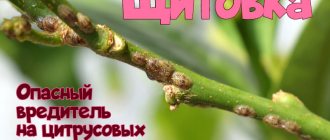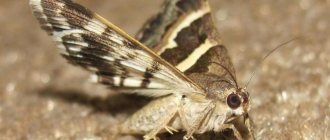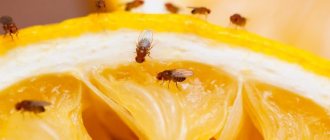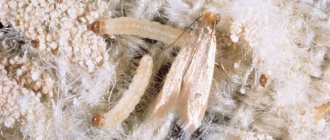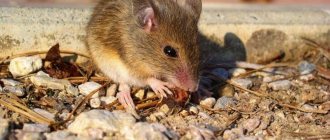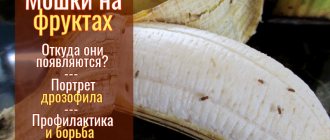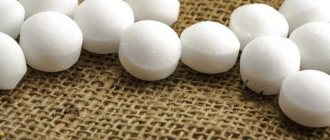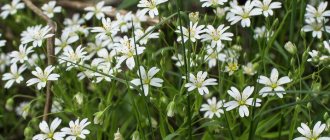- home
- Pest control
- Removing clothes moths in an apartment
- Types of moths
A moth is an insect that absorbs the substance of the stratum corneum - keratin. Such organisms are also called keratophages. But despite this, we often notice these insects crawling in the closet or flying around the house in search of woolen items. Why are they so attracted to wool? The answer is simple: at the molecular level, wool and fur contain the moth's favorite food product - keratin. Thanks to the unique environment of the stomach, which contains a lot of acid, moths easily digest keratin.
What you need to know about moths
The moth can be characterized by the following characteristics: it looks like a small butterfly of brownish-yellow, pale gray or white with a lot of silvery pollen on the wings. This insect goes through the following stages of development: the eggs hatch into larvae, then they become butterflies, and the adults, in turn, lay eggs. Moths themselves are practically harmless. You should be wary of larvae that hatch from eggs laid by butterflies in the fibers of things.
It is important to note that butterflies experience discomfort from sunlight, so they mainly live in dark places that are difficult for sunlight to penetrate - for example, in closets, closets and chests of drawers. The offspring hatched from the eggs, like butterflies, prefer to be in the dark, where it is almost impossible to detect the larvae. It should be noted that in the cozy conditions of city houses, moths are able to lay eggs all year round!
Habitat, lifestyle and nutrition
In nature, the variegated one lives in those places where balsam, fragrant, pyramidal poplars grow:
- in the European part of Russia;
- on the territory of the Caucasus;
- in the Central Asian region.
Adults don't feed. They live off what they stored in the caterpillar stage. But the larvae have an unusual throat. Young leaves eaten:
- drain;
- pears;
- apple trees;
- poplars and other trees.
Only the larva can gnaw a hole about 2 cm in diameter in the leaf. If there are a large number of pests, trees can be left without leaves in July-August.
Penetrating into a person’s home, poplar moths settle in chandeliers, lampshades, household appliances, containers with bulk products, and dried fruits. They also love different secluded places: behind furniture, heating radiators, and so on.
Lifespan of a moth
This is a rather important question, considering that insects actively eat clothing and furniture.
Before the onset of puberty, the individual goes through two stages of development: egg and larva. At an air temperature of 20 degrees Celsius, the laid egg takes two weeks to develop. The larval development period varies from three to ten months. At this time, the larvae form a cocoon around themselves from the nutrient material, in which they develop further.
After acquiring wings, the individual does not live very long - only 2-4 weeks. This period varies depending on the type of parasite. During these weeks, individuals are not particularly mobile and fly mainly in the dark, since the wings are poorly developed, which makes the insects very vulnerable.
If you add up the three periods of time during which the life of a moth occurs, you get a very impressive period of time during which the parasites do not waste time destroying interior items and wardrobe items.
What types of moths are there?
The most common types found in the home are:
Fur moth
The fur moth is an individual that has shiny dark yellow wings, with dark specks on the wings. The lower layer of the wings differs in color from the outer ones: they are light gray. The wingspan ranges from fourteen to fifteen millimeters. The fur moth prefers to feed on clothing made from natural materials. The hatching larvae look like worms, have white, almost transparent skin, through which the contents of their stomach can be seen, and eight very short abdominal legs. The larvae prefer to consume fur products.
Clothes moth
The clothes moth is larger in size than the fur moth; its wingspan is up to twenty-two millimeters. She also has two pairs of wings, which are purple at the very base, turning yellow towards the middle, with a small brown spot at the very top. The clothes moth larva is covered with a small white fluff and is similar in appearance to the coat moth larva. But, unlike their relatives, clothes moth larvae prefer to huddle in folds or inside woolen material, eating fairly large spaces of material that are invisible from the outside at first glance. The larvae are kept on clothing by a stationary cover.
Furniture moth
Furniture moth - a representative of this species has shiny silver-yellow wings, the head is dark yellow, and the base of the wings has a brown tint. This variety of keratophages has a significant difference from all other species and thanks to this it was declared a separate genus. This difference is the absence of oral tentacles. Furniture moth larvae destroy furniture in a unique way: first, the hair padding in the soft parts is eaten, then, closer to the pupation period, the larvae appear on the surface of the upholstery and begin to gnaw tunnels in the furniture cover. Pupation occurs on the lower surface of chairs, armchairs, sofas, and beds. In such places, a huge number of light cocoons accumulate. The period of development of larvae depends on the time of year: in winter it is five months, in summer – about two months. Pupation, as a rule, occurs towards the end of winter, that is, in February.
Ways to fight
Having discovered a moth in his home, the owner is often confused and bewildered, not knowing how to properly, and most importantly, effectively fight such an insect. Getting rid of an unwanted butterfly should begin only after identifying its species. Each type of moth has its own methods of treatment and preparations.
With fur moth
Moth that spoils a fur coat
The activity of fur (fur, wool) moths occurs at the end of spring (May). It is during this period that its butterflies are found in large numbers. The peak of their activity continues until mid-summer, and the insect can only be seen in the evening or at night (the wool moth does not appear during the day). In rare cases, this butterfly can manifest itself in winter. Having appeared in the room, the fur moth immediately begins searching for the most suitable place to lay eggs. Most often, this pest chooses to lay eggs a woolen or fur item lying in the farthest corner of the closet. An insect can parasitize on it for years, while the owners unsuccessfully struggle with the consequences of its activity in the rooms.
Advice! If suddenly moths are flying around your home, try looking into the nooks and crannies of your closet. Perhaps there you will find an old woolen thing that has become a breeding ground for the pest and a place where eggs and larvae accumulate.
The oviposition of a moth butterfly is immediately noticeable, despite its small size. It is white in color and is often located on the surface of things.
Having discovered a pest butterfly in the house, every housewife will probably think about how to save a fur coat from moths. The best way in this case would be to carry out preventive measures, which include the following actions:
- With the onset of spring, it is necessary to carry out general cleaning in the house, throwing away unnecessary and old things that can become a wonderful treat for a butterfly.
- Before putting them into storage, winter items are thoroughly ventilated, cleaned, dried, and then treated with a special aerosol moth repellent. Now such drugs are presented in a wide range and help fight not only the butterflies themselves, but also their larvae and eggs.
It should be understood that if moth eggs are not removed in a timely manner, then after 10 days white larvae will hatch from them. They cause serious damage to fur clothing.
Coat moth larva
If a fur moth does appear in your things, then it should be destroyed immediately. Fortunately, now there are many means and chemicals to combat such insects. And if you still don’t know how to get moths out of a fur coat, we suggest you familiarize yourself with the most effective means that currently exist:
- Ultraviolet rays are an excellent moth repellent for mink coats or other fur products. The fact is that this insect categorically does not accept exposure to direct rays of the sun, from which protein coagulation occurs in its body. To get rid of moths that have already settled in, it is recommended to take the clothes outside and quartz them with a special ultraviolet lamp. Directly directed rays contribute to the death of moth oviposition within one hour.
- Many owners of expensive fur products are interested in how to protect a mink coat from moths without harming the appearance of the clothing. The quartzing procedure can cause the color of the fur coat to fade, which is undesirable. There is another effective way to get rid of moths, their eggs and larvae that have accumulated on a fur garment. It is associated with dry heat treatment of the product through exposure to hot steam.
Quartzization of the room
- Does not tolerate moths and exposure to low temperatures. If suddenly a pest has infested your favorite fur coat, it will be enough to freeze the item for 24 hours. This approach will also get rid of the larvae and eggs of harmful insects.
- Radical remedies for wool moths will be chemicals. They are usually represented by sprays based on dichlorvos. As you know, moths cannot tolerate strong odors and fly away. It is recommended to use such means to treat clothing contaminated with oviposition and larvae of the pest butterfly.
- Products in the form of tablets, plates and gels also help effectively fight moths. These include the well-known Molemor, Suprozol-spray, Antimol, anti-moth sections, Raid-antimol, etc. When using chemicals against moths, you should remember their toxicity and strictly follow the instructions for use. When treating things and rooms with anti-moth chemicals, it is advisable to protect the eyes and respiratory tract with personal protective equipment.
With food moth
The appearance of food moths in the kitchen is not uncommon. Such a guest is unlikely to be interested in woolen items, but food will be her favorite delicacy. Getting rid of food moths forever is much more difficult, and often it is not possible at all.
This is what a food moth looks like
The moth, which prefers to live in bulk food, has a large body size, and can be recognized by its wings with black spots. The appearance of this insect in the house is facilitated by low-quality products purchased at the market or in a store. Most often, an unwanted guest settles in cereals or flour. Butterfly larvae can live for several months completely independently, without receiving food at all. The main sign that your cereals have food moths is the presence of cobwebs and tiny worms (these are food moth larvae).
Food moth larva
If such a scourge has been detected, we recommend that you immediately review all bulk food products. If there were medicinal herbs near the cereals, they should also be sorted out. If you find larvae in any product, immediately throw it in the trash. To completely get rid of the insect, you should treat the cabinet in which cereals, dried fruits and bulk products were stored with a vinegar solution. Its pungent smell will drive away the remaining pests and block their path to food for a long time.
Attention! To prevent the appearance of food moths, try to store cereals in glass containers with tight-fitting lids.
Storing cereals in glass containers
With wax moth
This is what a wax moth looks like
The large wax moth is becoming a real problem for beekeepers and beekeepers. The appearance of such an insect nullifies all the work. The moth simply eats all the honeycombs, leaving the beekeeper with nothing. Most bee lovers try to protect themselves and their pets in advance from the attacks of such a pest, looking for recommendations that will allow them to find out exactly how to deal with wax moths in hives. Every beekeeper should remember that honeycombs should be stored in a well-ventilated place where there is natural air circulation. The best option for storing honeycombs would be dense cases in which beekeeping tools are placed on top of each other.
Before storing honeycombs for long-term storage (after the end of the honey collection season), it is advisable to fumigate them with sulfur. Also, in order to prevent the appearance of wax moths, approximately 150 ml of carbon disulfide or 50 mg of formaldehyde should be added to the hives. In addition, professional beekeepers know well that butterflies and wax moth larvae are unlikely to appear if the honeycombs are well sprinkled with entobacterin.
Beneficial properties of wax moth
The wax moth, which is also popularly called the moth, has one amazing feature. Her body is the only one in the whole world capable of digesting beeswax. This butterfly, penetrating inside the beehive (where bees must live), lays eggs there, from which larvae then emerge. They feed on wax from bees' honeycombs. It is interesting that a long time ago beekeepers considered this insect a pest, but today the wax moth belongs to medicinal products. Many readers now probably have a question - what does wax moth treat and how, exactly, does such treatment occur? The fact is that Mechnikov discovered a special enzyme that is present in the body of this insect and has a detrimental effect on mycobacterium tuberculosis. Yes, yes, wax moth is a very useful remedy for tuberculosis. A special tincture is made from the larvae of this butterfly, which is then used for healing. The moth larvae contain the enzyme cerrase, which helps dissolve the walls of bacteria that cause irreparable harm to the human body. Doctors have noticed that it promotes the breakdown of not only Koch bacilli, but also a variety of viruses with cancer cells.
Wax moth tincture
Wax moth larvae also contain polysaccharides and monosaccharides (including galactose and fructose), as well as fatty acids and amino acids that have a beneficial effect on the regeneration processes of old cells.
There are many indications for the use of tincture based on moth larvae:
- Asthma, bronchitis. The drug helps improve expectoration and drainage function of the lungs. Preparations based on wax moth larvae are allowed to be used in the treatment of chronic and acute bronchitis (not only in adults, but also in children).
- Tuberculosis. The enzyme cerrase, already noted above, produced by moth larvae, has a powerful effect on the walls of Mycobacterium tuberculosis, causing their destruction and making them more vulnerable to the immune system and drugs. Treatment of people with tuberculosis using wax moth tincture does not entail the development of complications and the destruction of microorganisms beneficial to humans (as is the case in the case of treating tuberculosis only with pharmacological agents).
- Postoperative recovery. Serotonin proteases present in moth larvae prevent the formation of postoperative adhesions and scars. Wax moth tincture will be useful for postoperative patients whose sutures do not heal well or have extensive purulent inflammation.
- Infertility. Wax moth also has an excellent effect on disorders of the reproductive functions of men and women. A drug based on it helps to increase erection and sperm activity in males, and in females, tinctures from moth larvae make the vaginal microflora healthy and improve the functioning of the ovaries. Medicines based on wax moths also have a good effect during pregnancy. They supply a large amount of microelements and vitamins to the blood. The use of such drugs eliminates the risk of developing anemia in the expectant mother.
- Depressive states. Wax moth larvae contain serotonin components, which are responsible for improving mood and performance. A tincture of moth larvae can be used by people prone to depression and ordinary citizens during periods of autumn or spring blues. The composition of this product is so useful that it will help not only cope with a bad mood, but also protect your body from the effects of respiratory infections.
Separately, it is worth mentioning where to buy wax moth tincture? It is clear that it is unlikely that you will be able to prepare it at home (unless you are the owner of an apiary). Pharmacies and beekeepers themselves distribute this drug. When preparing such a tincture for sale, it is important to understand that only moth larvae that have not yet reached the pupation stage are suitable for it. Following this rule is extremely important because immediately before pupation (the intermediate period before the caterpillar becomes a butterfly), the larva stops consuming food and its body is not saturated with useful components. Naturally, such individuals do not carry any therapeutic effect. When purchasing a medicinal solution based on wax moth, pay attention to the presence of instructions with recommendations for use. If there are none, then it is better not to purchase the tincture, since, most likely, it is a fake.
With furniture moth
You can fight furniture moths using various methods. The measures taken will depend on whether the pests have already appeared or not. Preventive methods of control are aimed at preventing the appearance of furniture moths, and elimination methods are aimed at getting rid of existing insects.
This is what a furniture moth looks like
Among the elimination measures to combat moths in furniture, the following can be identified:
- Mechanical removal of moth larvae and eggs;
- Warming up furniture and treating it with a quartz lamp;
- Treatment with aerosol insecticidal preparations.
Preventive ways to combat furniture moths in rooms include regular ventilation of the premises, periodic cleaning and washing of furniture, and treating them with disinfectants.
Mothballs can be used to effectively remove adult moths. This remedy has long proven itself to be good, but still has a serious side effect in the form of the presence of carcinogens that are harmful to human health.
The fight against moths that have already appeared on furniture involves mechanical removal of moths, egg-laying eggs and larvae, as well as washing pieces of furniture. An additional effect is created by chemical agents, divided into fumigation and contact.
Contact preparations are represented by various aerosols and insecticidal solutions. They are applied directly to the moth-infested furniture surface. The larvae, crawling on the surface treated with such means, will eat toxic substances and will soon die from them.
Fumigation preparations for controlling butterflies and moth larvae are available in tablets and plates. They are placed in places where moths and their larvae are expected to be located. The destruction of insects occurs due to the aromatic fumes emanating from these drugs. Now manufacturers of insecticidal products against moths offer customers a wide range of their products. The category of aerosols includes Raptor “Moth Protection”, “Armol Expert”, “Moskitol”. The most effective plates against pest butterflies are “Dezmol” and “Antimol”. Morimol, Foxide, Mittox and Supromit solutions will also help protect upholstered furniture and carpeting in the room.
With potato moth
This is what a potato moth looks like
Potato moth is one of the most dangerous pests of potato tubers. It is worth taking measures to combat such a pest during the period of growing potatoes, as well as after harvesting, during its storage. The potato moth is a small gray-brown insect. Its larvae gnaw long tunnels inside potato tubers, causing gradual blackening of the fruit.
Consequences of potato moth
Faced with a similar problem, most gardeners do not know how to deal with potato moth. It is extremely difficult to remove this pest, so you should prepare in advance and properly for storing potato tubers. The procedure for exterminating these insects must be carried out systematically and comprehensively, in accordance with the following principles:
- Healthy potato tubers should be planted at the maximum possible depth, after warming them up.
- It is recommended to regularly hill up and loosen potato plantings.
- Potato tops must be mowed and destroyed in a timely manner.
- Immediately after harvesting potatoes, it is worth treating them with special anti-moth products. Such potato pests will not be able to resist Entobacterin, Dendrobacillin and Lepidocide. The potato treatment product Prestige has also proven itself to be effective in the fight against potato moth.
- It is recommended to store the potato harvest at a temperature of 3-5 ºC to avoid the appearance of butterflies and moth larvae.
Thus, measures to combat potato moth combine chemical and agrotechnical measures. It is necessary to take care in advance of preparing the place for storing potatoes, clearing it of any debris. The potato storage facility must not only be clean, but also thoroughly disinfected. Before storing the tubers, it is advisable to clean them from obvious dirt and dry them in the open air.
If there are still moths in the storage area where potatoes are stored, you can try using so-called sulfur bombs for greenhouses. When such a bomb burns, a gas called sulfur dioxide is released into the air. It has a detrimental effect on the body of the insect pest. Sulfur is burned in the basement where potato tubers are stored at the rate of 50 per 1 m3. The scope of application of sulfur bombs is not limited to cellars. They are also used for disinfecting polycarbonate greenhouses, houses and warehouses. Fumigating the cellar with a sulfur bomb allows you to dry the cellar and prevent the development of mold, rot and fungal diseases in it. You can buy such a device in a specialized store or make it yourself by watching a video on how to make a smoke bomb.
With apple moth
Apple moth is a very serious pest of garden trees. Such moths harm not only apple trees, but also other fruit trees (plums, apricots, cherries, pears).
Apple moth
A distinctive feature of the apple moth butterfly is the light gray or white color of its wings. The caterpillar of this pest has a greenish color and two rows of black dots. It is the moth caterpillars that cause cobwebs to appear on the leaves of trees, which subsequently destroys all the foliage on individual branches. If a small tree is severely affected, there is a risk that it will completely lose its vegetative parts.
Consequences of apple moth
Pests of fruit trees can cause irreparable damage to gardening and the fight against them should therefore begin as early as possible.
- Before flowering begins, it is advisable to treat trees with insecticidal agents.
- To control the presence and number of apple moths, it is recommended to hang pest traps on fruit trees throughout the garden.
- Moth-infested leaves of an apple tree or other trees must be promptly collected and destroyed.
- The natural enemies of apple moths are braconid wasps. They should be attracted to the garden when pests are detected.
- If necessary, additional chemicals can be used.
With chestnut moth
This is what a chestnut moth looks like
The chestnut moth parasitizes mainly on horse chestnut trees (sometimes it can be found on maple trees). This insect has practically no natural enemies, so it poses a serious danger to the above-mentioned trees. The caterpillar of the chestnut moth forms long passages called mines in the leaves of the tree. During the development process, the caterpillar molts, leaving a dark, unsightly spot at the molt site. Before the caterpillar turns into an adult, it destroys up to 90% of chestnut leaves.
The main measures to combat the chestnut moth are feeding the trees and introducing special chemicals into the tree vessels, the basis of which is Imidacloprid. This component saturates chestnut leaves with substances poisonous to moths. A method in which the so-called Trichogramma ichneumon is attached to the larvae also has a good effect.
With ermine moth
This is what an ermine moth looks like
The ermine moth is an insect from the Lepidoptera family, which includes more than 600 species. Most often, varieties of ermine moths are found in the tropics, but some of them have adapted to life in Russia. The main source of food for ermine moths is vegetation (mainly leaves, less often roots). Settling on the stems and leaves of vegetation, the caterpillars of this butterfly quickly entangle them in a web, stopping the supply of nutrients. Several hundred caterpillars can exist independently of each other on one tree. The ermine moth causes great harm to agriculture and forestry. In Russia, this species of harmful butterfly can be found on apple trees and bird cherry trees. By depriving the plant of leaves, this insect provokes a slowdown and complete cessation of its growth, lack of fruiting and flowering.
The main method of combating ermine moths will be timely prevention and treatment of wood with chemical insecticidal preparations or biological agents. If the area affected by the tree is small, then the nests of moths can be collected manually, and leaves damaged by the pest can also be collected. They are then burned along with the larvae outside the garden plot.
Among the most effective insecticidal preparations used to combat ermine moths are:
- Arsenic solution;
- Bordeaux mixture;
- Danadim;
- Lepidocide;
- Bitoxibacillin;
- Aktellik (for private gardening farms).
The first treatment is carried out in May, but care should be taken, since the above-mentioned agents are extremely toxic. You can treat the plant again in early July.
There is also a folk method of fighting ermine moths. A solution is prepared, the basis of which is a bucket of water, in which a pack of shag tobacco, a bag of red pepper, onion and garlic peels, and a bottle of potassium permanganate are diluted. The prepared mixture is infused for three days and then sprayed on the trees. This drug can be replaced with regular Coca-Cola.
With poplar moth
This is what a poplar moth looks like
The poplar moth is a small white butterfly that is predominantly nocturnal. It harms agricultural products, but mainly settles on green plantations of poplars of various types. The color of the poplar moth is inconspicuous, but there is slight variegation on the front wings. The caterpillar of this pest does not exceed 5 mm in length.
As for the methods of combating poplar moths, it is worth considering that this pest does not cause any damage to humans. True, sometimes moths cause inconvenience by settling on the ceilings and windows of homes. The main means of combating poplar moths now is to spray the crowns of poplars and the soil around their plantings with strong pesticides.
Agricultural pests
It is better to study the enemy thoroughly so as not to get confused if you suddenly have to meet him not only in the apartment, but also in the garden! It is quite common for entire colonies to attack agricultural crops, poisoning the lives of gardeners. Let's look at several main types of moths:
grain moth
The grain moth is a species of keratophagous silvery-white with a small bright brown pattern on the fore wings. They can also be recognized by their gray belly and wings, the span of which reaches up to fifteen millimeters. Pupation occurs primarily in spring and summer. Grain moths can most often be found in barns, warehouses, granaries and other places where grain crops are stored. An individual grain moth lays up to a hundred eggs directly on grains: one or two eggs are glued to each grain. The female combines several grains into a kind of lump with the help of a sticky liquid secreted, similar to a web, and eats them while inside this lump of web. To move, she has to drag the entire bundle behind her. This type of moth prefers to pupate in cracks in the floor and walls. In addition to grains, moths also eat dried fruits and various seeds.
Rye moth
Rye moth - this species has a wingspan of up to thirteen millimeters. The hind wings are dark yellow, with a brownish edging. The most common rye moth is found in central Russia. Individuals prefer to lay eggs towards the end of summer on wild cereals and on emerging winter crops. The larva eats the core of the stem and spends the whole winter in it. Pupation of rye moth larvae occurs closer to mid-summer.
Folk remedies
Before using harmful chemicals, you should try to remove insects from your home using safe methods - traditional ones. You need to study the methods in advance, choosing the one that suits you. It is worth remembering that folk remedies will not kill, but will only scare away the pest, so they must be used in combination with mechanical methods (for example, using a vacuum cleaner).
Various plants and herbs have a depressing effect on pestra. You can make a wreath or broom from the following plants:
- sagebrush;
- tansy;
- lavender;
- rosemary;
- mandarin.
Herbs can be put in fabric bags and scattered around the apartment. If there are too many moths, this method will not help.
Poplar moths do not like the smell of cedar essential oil, so it is used to make home remedies
The smells of essential oils - cedar, wormwood, eucalyptus, tea tree - have a deterrent effect. They can fill the phytobarrier and place it in the place of greatest concentration of moths. The capacity needs to be renewed every month. This will not only get rid of poplar moths, but will also give the room a pleasant aroma. You can place dry lavender branches, strawberry-scented soap, and orange peels in dark places.
Previously, housewives made pestra cubes, laying them out throughout the apartment.
To prepare them you will need:
- a few drops of lemon oil;
- detailed cedar bark - 115 g;
- myrrh - 115 g;
- cinnamon - 115 g;
- soap powder - 35 g;
- a few drops of alcohol;
- ground black pepper - 115 g.
The ingredients are mixed, alcohol is added until a sticky mass is formed. The resulting composition is used to make cubes that are laid out behind curtains, near windows, and household appliances.
An easier way to prepare cubes is to take 500 g of alabaster, add 50 g of ground black pepper, and pour in 40 g of naphthalene. Alcohol is added to the mixture until a ball is formed. They are scattered throughout the housing.
A sachet against moths gives an excellent effect. To make it, you will need to take 500 g of lavender, 1.9 kg of camphor, 30 ml of lavender ether. They are mixed, finely chopped and placed in boxes or bags.
You can make paper with an insect repellent scent.
To do this you need to mix:
We advise you to read:
How to deal with the smell of sweat
- 25 g camphor;
- 15 ml cedar oil;
- 25 g phenol;
- 350 ml gasoline or kerosene.
When preparing the mixture, you must follow safety precautions, as it is flammable. Some components are harmful to pets, so it is better to give your pets someone to look after during the procedure.
If pestra is noticed on indoor plants, they need to be treated. You can use a solution of laundry soap. Pieces of soap with the scent of citrus, mignonette, and lily of the valley can be placed in places where moths are spotted.
The insect does not like the smell of cedar, lavender and cloves, lemon, orange. If you buy flavors with these aromas, there will be significantly fewer individuals. You can soak tampons with essential oils of plants and place them in inconspicuous places in your apartment. Instead of orange essential oil, you can use fresh fruit peels. As they dry out, about once a month, they will need to be replaced with new ones.
Indoor plants will help drive away moths. Insects cannot stand proximity to geraniums, tobacco and nettles, so it is advisable to place them on windowsills. The smell of leaves will scare away unexpected guests - pests will not be able to enter the home through the windows.
Tobacco in a fabric bag is another effective means of repelling poplar moths. It needs to be laid out on the window sills and on the floor. Having sensed a pungent odor, insects will not stay in the apartment for long.
Dried chestnut fruits will also help you forget about the unpleasant problem. They are laid out in places where moths are spotted.
Important! When using folk remedies, you need to remember that they help scare off adult moths; you will need to get rid of the larvae using more radical methods.
Potato moth
This representative of parasites does not have the most attractive appearance: the wings are dirty gray in color and dotted with dark spots.
But in the larval stage, the individual is more pleasant to look at and has a light green (sometimes pinkish) color.
Having fledged, the individual acquires long mustaches and a body length of up to seven millimeters with folded wings. Life in this stage lasts only a few days.
The unprepossessing appearance appeared for a reason: it helps the pest remain unnoticed, even if you look at it, as they say, “point-blank.”
Females lay eggs on the surface of leaves on the underside. The larvae that hatch after some time develop very quickly.
As the name suggests, potato plants suffer from parasites. Individuals can remain alive until the temperature drops to 4 degrees. But individual individuals can climb into the tubers themselves and continue to exist there. Potato moths wait out serious cold weather, as a rule, in barns, which have enough seed potatoes for food. With the same potatoes, parasites re-enter the soil in the spring.
Cabbage moth
This parasite causes damage to cruciferous crops. Externally it differs from other types of moths: the body is oblong in shape and light green in color, covered with small hairs. You can easily confuse an insect with a straw if it folds its wings. The wings themselves are framed with fringe at the edges. The larvae have characteristic brown heads.
In terms of activity, cabbage pests are no different from the rest: they are inactive, fly poorly, and rarely move very far from the place where the cocoon is left. Parasites lead a solitary lifestyle and rarely gather in groups. On a leaf you can see one, maximum two individuals.
It is easy to detect and identify the eggs of the parasite: they are elongated and very small. The egg is up to 0.5 millimeters long and only 0.2 millimeters wide. The green color perfectly camouflages them on the foliage.
food moth
It parasitizes inside products whose storage conditions have been violated. These are mainly stocks of cereals and groceries in barns. Parasites also find food for themselves in the wild: nuts and crop fruits become prey. For this reason, food pests can often be seen in steppe and forest-steppe areas.
It is curious that this type of moth is not able to cause harm to furniture and clothing, since it can only consume cereals, flour, sugar, dried fruits and berries. Appearance: body length with folded wings is eight millimeters. The discreet color makes the parasite almost invisible.
The caterpillars have a pinkish or light yellow color and a smooth body. Ideal conditions for development are: temperature up to +25 degrees, humidity up to 50%. All life stages of an individual take no more than six weeks.
Chestnut moth
The foliage of maple and horse chestnut suffers from it. After spending the entire winter in the pupal state, adult insects emerge with the first warmth. Reproduction processes soon begin, which end with the appearance of new offspring within a couple of weeks. The young growth immediately clings to fresh foliage. This causes early leaf fall and tree death.
The destructive activity of the parasites can be seen by uneven orange spots on the leaves.
Signs of plant damage
The fact that poplar moths have appeared on trees can be understood by the fact that traces of caterpillar life appear on their leaves. Their shape depends on the type of wood:
- On apple leaves, the passages can be round or serpentine.
- Brown or beige markings appear on pear leaves.
- Small holes appear on rose leaves.
- Light passages and dots are visible on damaged lettuce and violet leaves.
- You can see white dots on the leaves of the cucumber.
- When infected, light zigzag marks appear on the leaves of chrysanthemums.
Difficulties in killing moths
The shelves of hardware stores are filled with insect repellents. However, modern pests can extremely quickly adapt to what they are trying to poison them with. This complicates the disinfestation procedure. You have to change medications regularly. And despite all this, final victory rarely comes.
In view of this, it is easier to take care of preventing the appearance of pests. Preventive measures will vary depending on the type of moth. Recommendations on the algorithm of actions in your situation should be obtained from specialists.
Fighting whitefly
The whitefly is a harmful insect of small size and white color. These butterflies are localized on the inside of tree leaves and therefore are practically invisible.
This is what a whitefly looks like
To understand how to deal with whiteflies at home, a gardener needs to be familiar with the main signs of the presence of insects on a plant:
- When you touch the stem and leaves, whitefly butterflies immediately fly up from underneath.
- On the underside of the leaves, where butterflies accumulate, there is a sticky coating in which fungi multiply. Because of them, the leaf first acquires a white tint, and then gradually turns black.
- Whiteflies carry viral diseases from plant to plant, causing deformation of stems, leaves and cessation of shoot growth.
If vegetable or other cultivated plants in the garden are affected by whiteflies, then the main measure to combat it will be to treat them with insecticidal agents. The drugs Actellik, Confidor, Fufanon, Pegasus, Fosbecid will be effective in this case. The number of sprays and recommendations for diluting the preparations can be found in the instructions for them.
The whitefly causes great damage to agricultural land and its control must be high-quality, effective and timely. Folk remedies against whiteflies have proven themselves well. It should be remembered that such pests react extremely poorly to cold, so a plant affected by this type of moth can be moved to a cooler room for preventative purposes. But at the same time, it is worth clarifying whether such a movement will have a negative impact on the vegetation itself.
So-called glue traps against whitefly moths have become very popular among gardeners. An ordinary plywood sheet is painted bright yellow, and spread on top with a layer of adhesive (honey, castor oil or rosin). The bright surface will attract butterflies, and the glue will prevent them from flying away. Regular sticky fly strips can also be used as moth traps.
There are also more neutral ways to deal with whiteflies. They are used if whiteflies have infested indoor flowers. It helps in this case:
- Infusion of yarrow. The leaves of this plant are taken in the amount of 80 g per 1 liter of water and infused for one day. Large plant leaves are wiped with a cotton swab, and flowers with small leaves are sprayed.
- Garlic infusion. Add a tablespoon of finely chopped garlic to a liter of water. The composition must be infused for one day.
- 1 part of crushed soap is dissolved in 6 parts of water, and then the leaves of moth-infested plants are wiped with the prepared solution.

